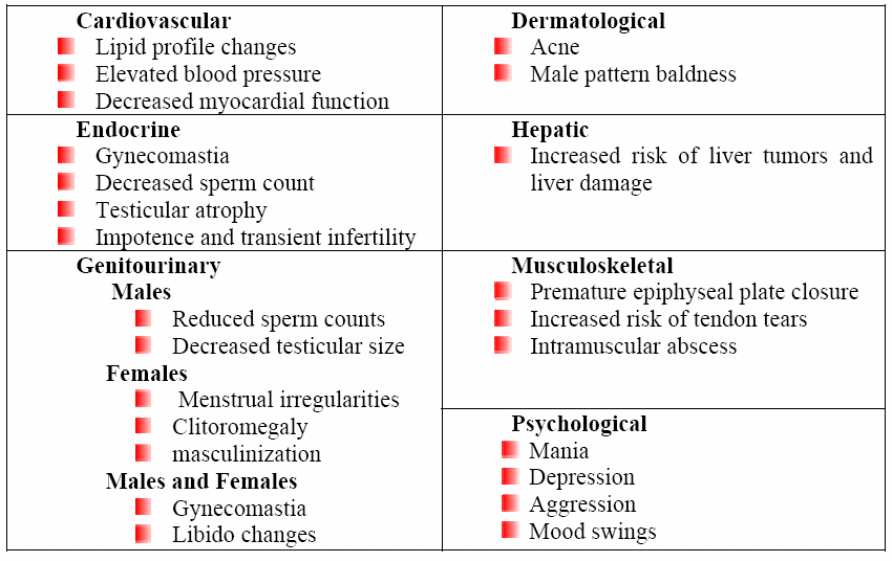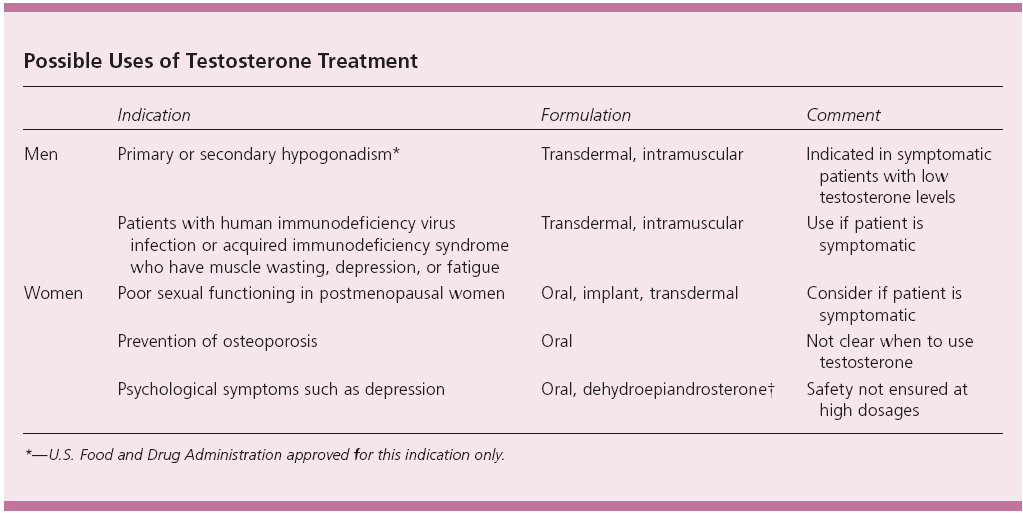Current Research limitations
Anabolic steroids (AS) exert multiple actions affecting both the body’s organs and its physiology. Information about their side effect depends mainly on animal studies. The most extensive research in humans of side-effect profiles has been in those treated with AS due to severe medical illnesses. Again, it is difficult to apply these clinical findings with any degree of certainty to ‘healthy’ individuals who use AS. The medical literature comprises mostly single case reports and does not prove a link between cause and effect and it is possible that the individuals concerned may have developed the illness in the absence of AS.
The research conducted has usually been in groups of AS users who have been using their own regimes of drugs, with subjects using different types of AS and dosages. Therefore, no single AS can be individually analyzed and any findings in the research have to be applied to the generic group of drugs termed anabolic steroids. As polydrug use among AS users is common, it can be difficult to prove conclusively a direct cause-and-effect relationship between AS use and the disease process (Lenehen pp. 31, 32).
Anabolic Steroids side effects
The concept that testosterone (the first anabolic steroid used) is naturally secreted in the human body and extra-physiologic levels produce no harm has proved not only wrong but threatening human health and life. Further, while some AS side effects are noticeable clinically, others are silent and may pass unnoticed until a serious medical complication develops (Warpeha p. 15). Skeletal muscle obviously develops strength and mass after periods of weight training and exercise. The heart can also increase in size as the same exercises will cause the heart to work harder in supplying oxygenated blood to the working muscles.
Hypertrophy of skeletal and heart muscle is a result of increased protein synthesis due to this repeated resistance loading, but stimulation is by two different mechanisms (Lenehen, p. 34). Skeletal muscle mass is increased by creating resistance with overloading (e.g. weight training) and cardiac mass is increased by the additional after-load created by the arterial system blood pressure surges that are produced during such exercises.
The exogenous use of AS increases the size of skeletal muscle but it is not proven that AS can produce the same effect on heart muscle. Most studies using echocardiograms to monitor the size of the heart in AS users have found no differences between AS users and with those who train and do not use steroids. There was normal growth of septal and left ventricle heart walls but no changes in ventricular chamber size or disproportionate septal thickness. It is apparent that the increase in heart size with exercise is merely a proportional rise with the gain in skeletal muscle bulk and the exogenous use of steroids does not potentiate the effect of training on heart size (Warpeha pp. 15, 16).
Evidence suggests that myocardial infarction, stroke, sudden cardiac death, and cardiac muscle damage (on long term use) link significantly to misuse and abuse of AS (Ryan and Richard, p. 550). AS side effects on the cardiovascular system is not limited to the cardiac muscle. Warpeha (p. 16) reported other silent side effects as high blood pressure, thrombosis, and endothelial cells dysfunction with abuse of anabolic steroids. Disturbed lipid profile in the form of increased levels of low density lipoproteins (hazardous to human health) and decreased levels of high density lipoproteins occurs with prolonged abuse of AS.
The liver is another target organ affected seriously by AS. All forms of hepatotoxicity have been reported starting from increased serum enzymes to liver cell failure. Liver malignancies (hepatocellular carcinoma) and development of hepatic blood-filled cavities (peliosis hepatis) were also reported (Maravelias et al, p. 167). Psychological side effects were reported by Trenton and Currier (pp. 571, 572) in the form of aggression, irritability, euphoria, grandiose, and serious reckless behavior.
More seriously is the problem of drug dependence especially in the younger age group showing withdrawal symptoms like fatigue and depression. Hoffman and Ratamess (p. 184) summarized the side effect of anabolic steroids use according to the target organ (Table 1).

Anabolic steroids side effects in males and females
Margo and Winn (p. 1595) summarized the potential therapeutic of testosterone and anabolic steroid in males and females (Table 2) and compare the safety of their use in both genders.

Because of safety concerns and the lack of well-done, long-term studies, the use of testosterone and AS is limited for conditions approved by the U.S. Food and Drug Administration (FDA), being inapt for wide-scale use. For males safety issue focus on, although not limited to, prostate cancer and benign prostate enlargement thought to be stimulated by testosterone, since treatments for both conditions include androgen suppression.
There is evidence that testosterone treatment correlates to increased prostate volume. However, in short-term studies there is no compelling evidence of an increased risk of prostate cancer from AS treatment. On the cardiovascular system, concerns are considerable, being silent side effects, regarding the effects on the cardiac muscle, vascular system and changes in the lipid profile. The third chief concern is since testosterone is of value in managing anemia among males because high levels stimulate erythropoiesis, polycythemia can be an issue for non-anemic men especially those who are at risk of vascular disease.
Safety in females is still controversial, the characteristic side effects are alopecia, acne, and hirsutism; however, they are dose related and duration dependent. Other reported side effects in females are deep voice (low incidence), oily skin, acne, and male-pattern hair loss. In short term use, AS were not correlated to hepatic complications in females (Margo and Winn, pp. 1593, 1595).
Anabolic steroids side effects in adolescents
The NIDA report (pp. 1-3) looked at safety issues of adolescents’ AS side effects, because of the extent of use. The report states that (according to data from Monitoring the Future Survey, 2005-2006), 0.9% of 8th grade students receive AS, for 10th graders, the rate increases to 1.2%, and for 12th graders it increases further to 1.8%. The report shows that disapproval of AS intake did not change from 200 to 2006 among senior students although perceived risk of AS intake has increased from 56.8% in 2005 to 60.2% in 2006).
The main hazard of AS intake in adolescent is related to premature growth halt. The mechanism suggested is AS induce premature skeletal maturation and puberty acceleration. This points to the consequences for adolescents is life time effects especially if AS are taken before the adolescent growth spring out. Besides they are more prone to depression, aggression and especially on drug withdrawal. Adolescents who inject AS become more exposed to HIV/AIDS and hepatitis at an early age (NIDA, pp. 2, 3).
AS primary health care general practitioners are the first point of contact when medical problems arise, Lenehen (p. 58) reviewed the literature on survey results of how they look at the problem. Lenehen (p. 58), inferred nearly 2% of individuals who receive AS had been prescribed GPs mostly males for fertility or sexual dysfunction reasons. Thirty three percent had told their GP about the use of AS and 36% were receiving medical monitoring. In another study (after lenehen p.59) 45% of the surveyed individuals were taking AS privately again for fertility or sexual dysfunction reasons.
Work Cited
Hoffman, J. R., and Ratamess, N. A. “Medical Issues Associated with Anabolic Steroid Use: Are They Exaggerated?” Journal of Sports Science and Medicine 5. (2006): 182-193.
Lenehan, P. “The medical aspects of AS misuse (Chapter 3)”. Anabolic Steroids and other Performance Enhancing Drugs. Ed. Lenehan, P. London: Taylor & Francis, 2004.
Maravelias, C., Dona, A., Stefanidou, M., et al. “Adverse Effects of Anabolic Steroids in Athletes: A Constant Threat.” Toxicology Letters 158. (2005). p. 167-175.
Margo, K., and Winn, R. “Testosterone Treatment: Why, When, and How?.” American Family Physician 73 (2006): 1591-1598.
NIDA (National Institue on Drug Abuse). U.S. Department of Health & Human Services. National Institutes of Health. Steroids (Anabolic-Androgenic) Info Facts. By NIDA. March 2007. Web.
Ryan, H. C. W., and Richard, H. C. W. “Abuse of Anabolic Steroids.” Southern Medical Journal 98(5). (2005): 550-555.
Trenton, A. J., and Currier, G. W. “Behavioral Manifestations of Anabolic Steroid Use.” CNS Drugs. 19 (7) 2005. p. 571-595.
Warpeha, J. M. “Side Effects of Steroid Use.” NSCA’s Performance Training Journal Special Report, (2006): 15-19.